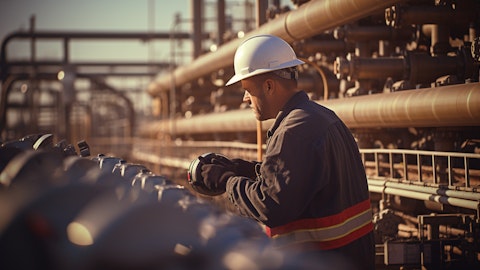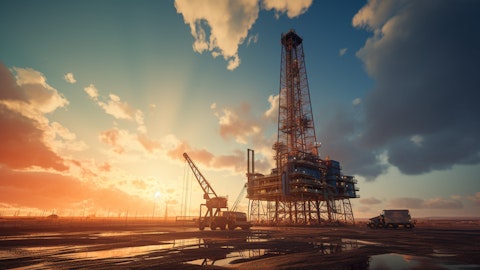BP p.l.c. (NYSE:BP) Q4 2023 Earnings Call Transcript February 6, 2024
BP p.l.c. isn’t one of the 30 most popular stocks among hedge funds at the end of the third quarter (see the details here).
Craig Marshall: Good morning, everyone, and welcome to BP’s Fourth Quarter and Full Year 2023 Results Presentation. I’m delighted to be here today with our newly appointed Chief Executive Officer and Chief Financial Officer; Murray Auchincloss; and Kate Thomson. Before we begin today, let me draw your attention to our cautionary statement. During today’s presentation, we will make forward-looking statements that refer to our estimates, plans and expectations. Actual results and outcomes could differ materially due to factors we note on this slide and in our U.K. and SEC filings. Please refer to our annual report, stock exchange announcement and SEC filings for more details. These documents, along with this presentation, are available on our website. Let me now hand over to Murray.
Murray Auchincloss: Good morning, everybody. Thanks for joining us today here at St. James. We’ve done this before, haven’t we? But it’s the first set of results where I have the privilege to talk to you as CEO of BP. It’s a great company. It has great people, and it’s an honor to lead. Our destination is unchanged, IOC to IEC, international oil company to integrated energy company. We’re confident in our strategy to deliver this, but are going to do so is a simpler, more focused and higher value company, providing energy solutions for our customers who are asking us to help, contributing to the energy transition, all the while remaining pragmatic and adapting in line with demand, as you saw with the update to our strategy this time 12 months ago.

So what does it practically mean to transition from IOC to IEC. Over 100 years ago, we started to create our first value chain, oilfields attached to refineries, with products sold in service stations and airports. We’re now introducing biofuels, sustainable aviation fuel and biodiesel to the customer. At the same time, we’re lowering the carbon footprint of our plants by using lower carbon hydrogen and electricity for power. Why? Because we can deliver higher margins with lower emissions. Over 60 years ago, we started to create the second value chain, natural gas fields linked to domestic pipeline systems and eventually liquefaction plants. We’re now introducing biogas, carbon sequestration and lower carbon electricity to the customer. Why?
Because we can deliver higher margins with lower emissions. And over the past 4 years, we’ve been accelerating our efforts to create a third value chain, lower carbon power and hydrogen. For example, using solar-wind to create lower carbon hydrogen to provide to our plants and customers and using those electrons to service the growing electricity demand through our EV charging business. Why? Because we can deliver higher margins with lower emissions. All of these chains are then optimized by our fantastic trading organization, driving superior returns to what a pure play can deliver. And the more we can interlink them, the more we can expand the returns. Over the past 4 years, we’ve delivered, on average, around a 4% uplift to group return on average capital employed across these chains through these efforts.
We think this is a sector leading. Now across all these chains, we’ve always have choice about how much we produce ourselves in the upstream or purchase from other producers. That equally applies to oil, natural gas and renewables. The magic is getting that mix right inside our business lines to optimize returns and trading optionality. The most important part is to ensure absolute discipline in investing [indiscernible] capital, ensuring we hit our return thresholds across these value chains. That’s what an IEC is to me, investing in today’s energy system while building out tomorrow’s, lower carbon, higher margin. Now it’s 4 years in. We’ve learned a lot and adapted along the way. It’s made us stronger, more confident in the growth we have coming and more convinced about the value we can create.
See also 15 Reasons Why Millionaires Think They’re Middle Class and 10 Best Cheap Car Insurance in New Jersey for 2024.
Q&A Session
Follow B P Plc (NYSE:BP)
Follow B P Plc (NYSE:BP)
I’m passionate about this strategy, as I think there are only a few companies globally that can do this at scale. And as we deliver, we will grow the value of BP, and that’s what I’m focused on, growing the value of BP. So what should you expect from us moving forward? As always, let’s start with safety. We’re making good progress, but there’s always more we can do. Delivering safety is very important to me, and it’s very personal. 4 generations of my family have worked in the sector. My great grandfather actually died in an industrial accident. And I can remember my father teaching me about the dangers of hydrogen sulfide and a natural gas field as a child. We work in a high hazard industry. And every day, we must make sure everyone comes home safe.
That’s our first priority. The past few years have been about generating options. Now we will focus our efforts on the key areas where we can be competitive, and we’ll simplify the business. We’ll pursue this in every way you can imagine from origination to our narrative. We will be relentlessly value and returns focused with our investments, focused on growing value and returns from our oil and gas portfolio, leveraging our high-quality resource base and driving efficiency and reliability, as we laid out in our update in Denver last year and growing value from our transition businesses as we invest with discipline in the pipeline we have developed and by creating even more value through integration. We will continue to be pragmatic in our approach to how we navigate this energy transition.
Yes, we want to help scale lower carbon energy value chains and position ourselves to profit from them, but we must remain flexible, adjusting in line with changing demands and societal needs, as you saw us do in February last year. And we have a tremendous team delivering this, and I want to ensure we place engineering science and technology, both digital and physical at the heart of the company. I’ve seen firsthand the impact and possibilities of innovation and digital solutions, including across the upstream and expanding our customer offer and improving our back-office processes. And some of you saw this for yourself in Denver. What’s really exciting, we see potential to do even more to transform our businesses. We’ve been working with AI, including machine learning and computer vision models for more than 5 years, and we have over 100 live AI case — use cases across the business now.
These proven enormous opportunity to help us capture increase margin and decrease spending. And finally, you can expect to see us continuing to make full use of our creative commercial muscle to optimize how we invest and create value with Aker BP and Lightsource bp providing excellent examples for the future. So to sum up, the destination is unchanged, but we’re going to deliver as a simpler, more focused and higher value company, unlocking the full potential of our assets and our people and growing the value of BP. So let’s turn to 2023 and what was a year of continuing delivery. Starting with safety, we have seen improvements in our safety performance, reducing our Tier 1 and Tier 2 process safety events, but we have more to do. We need to keep improving to eliminate all Tier 1 process safety events, continuing to apply OMS and constantly reinforcing and building on our operating culture across the business.
Next to our business performance, where we have delivered resilient operational and financial performance in 2023. Adjusted EBITDA was $43.7 billion. Operating cash flow was $32 billion. Net debt reduced to $20.9 billion, and average return on capital employed was 18.1%. We are executing our strategy with discipline across our oil and gas business and our transition growth engines, as I’ll come to in a minute. And we are delivering competitive shareholder distributions. We grew our dividend for ordinary share by 10% last year. Today, we announced a further $1.75 billion of share buybacks, bringing our total buybacks announced from 2023 surplus cash flow to $6.5 billion. We have seen strong momentum in our operational and strategic delivery in 2023.
Starting with oil and gas. Our upstream production grew by 2.6%. We started up 4 major projects that we expect to contribute more than 50% towards our target of 200 mboe/d by 2025. BPX production grew by 13%, surpassing 400 mboe/d in the fourth quarter. We managed base decline between 3% to 5%, supported by high return investments and new well delivery and well work. And in refining, availability was over 96% for the year. Our LNG supply portfolio increased by 20% to around 23 million tonnes per annum, largely driven by Coral and Freeport. In addition, we delivered 10 million tonnes per annum of incremental short- and mid-term merchant volumes. We completed Atlantic restructuring, enabling the next wave of projects in Trinidad and securing long-term LNG equity offtake.
We accessed 44 exploration blocks in Gulf of Mexico, Canada, Brazil and Deepwater Trinidad. Our unit production cost was around $6 per barrel of oil equivalent, in line with our 2025 target. And proudly under aim 4, we met our first goal of deploying our methane measurement approach across all our existing major operated upstream oil and gas assets by the end of 2023, a very important milestone. Turning to our transition growth engines in Bioenergy. We increased our biofuels production by 18% year-on-year and biogas supply volumes by 80% year-on-year, reflecting the uplift from Archaea. In convenience, we delivered 60% growth year-on-year in gross margin, including the contribution of TravelCenters of Americas. Excluding TravelCenters, we’ve maintained strong underlying growth of 9% year-on-year, building on the average 9% per annum over the previous 3 years despite recessionary forces.
In EV charging, we are rapidly building scale and demonstrating profitability in Germany and our JV in China. Energy we were sold rose by 150% year-on-year, supported by a 35% increase in the number of EV charge points and increasing utilization. Importantly, our charging customers in the U.K. are spending more in our shops than our fuel customers. This gives us further confidence in our fast on-the-go business model. We grew our hydrogen pipeline to 2.9 million tonnes per annum. Our focus this decade is on blue hydrogen and decarbonization of our refineries while laying the foundation for green hydrogen production towards the end of the decade. In renewables and power, we grew our renewables pipeline to 58.3 gigawatts net to BP, including the offshore wind award in Germany, Lightsource bp’s pipeline and our onshore renewables projects supporting hydrogen in Australia.





